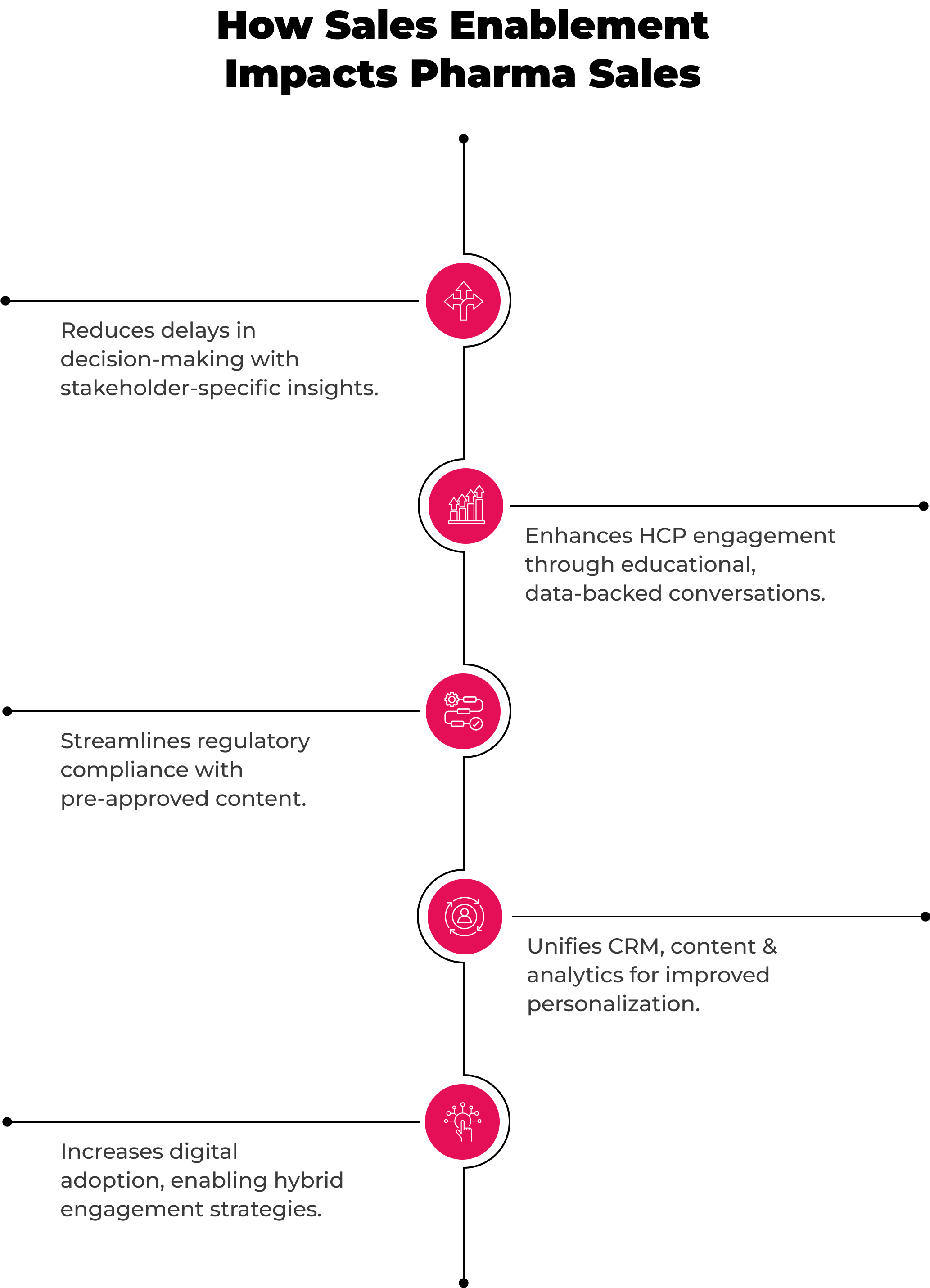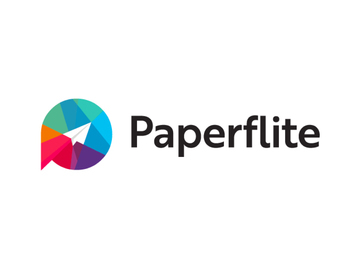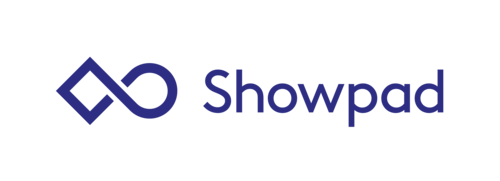Why Pharma Sales Teams Struggle - And How Sales Enablement Fixes It
Imagine this: A pharmaceutical sales rep spends weeks navigating approvals and engaging multiple stakeholders to promote a groundbreaking new drug. Just as the deal seems within reach, an unexpected compliance issue halts everything, stalling the sale and wasting valuable time.
This scenario isn’t rare. In fact, a 2024 study revealed that 65% of pharma sales professionals cite regulatory compliance as the biggest obstacle to closing deals. Combine that with long sales cycles and the challenge of engaging busy healthcare professionals (HCPs), and it’s no surprise that many pharma sales teams feel stuck in an uphill battle.
For sales and marketing teams, the pressure is real: How do you stay compliant, manage complex stakeholder relationships, and still hit your sales targets?
This is where pharma sales enablement steps in, offering the tools and strategies to streamline processes, enhance engagement, and ensure compliance without slowing down sales.
Summary
Pharmaceutical sales and marketing teams encounter three key challenges:
- Prolonged sales cycles
- Complex compliance requirements
- Inefficient stakeholder engagement
Sales enablement addresses these issues by streamlining processes, ensuring compliant content delivery, enabling data-driven engagement, and aligning stakeholders.
In this blog we will delve into the unique challenges faced by pharma teams, the role of sales enablement, its impact on efficiency and compliance, practical implementation steps, and essential industry tools.
- What is Pharma Sales Enablement?
- Key Aspects of Pharma Sales Enablement:
- Why is Sales Enablement Important for the Pharmaceutical Industry?
- How Sales Enablement Impacts Pharma Sales
- Key Impacts of Pharma Sales Enablement:
- Implementing Sales Enablement in Pharma
- Top Sales Enablement Tools for the Pharma Industry
What is Pharma Sales Enablement?
Pharma sales enablement equips sales reps and marketers with compliant, relevant, and impactful content while streamlining stakeholder engagement processes. It ensures that teams are not only informed but also empowered to deliver data-driven, persuasive messaging within regulatory frameworks.
Key Aspects of Pharma Sales Enablement:
- Centralized, Regulation-Ready Content: Ensures all marketing materials and sales content meet compliance standards.
- Real-Time Analytics: Helps reps understand stakeholder behavior and tailor their engagement strategies.
- Secure and Compliant Content Sharing: Builds trust with healthcare professionals (HCPs) while adhering to strict regulations.
Why is Sales Enablement Important for the Pharmaceutical Industry?
Pharma sales enablement is crucial for addressing the industry’s inherent complexities, from long sales cycles to strict compliance mandates. Let’s explore these challenges and how sales enablement offers solutions.
Challenge 1: Long Sales Cycles
- Issue: Decision-making in healthcare often involves multiple stakeholders, from physicians to regulatory bodies, which delays the process.
- Solution: Utilize analytics to track decision-making patterns and provide stakeholder-specific, evidence-based benefits. Sales enablement tools can identify key decision-makers and optimize outreach strategies.
Challenge 2: The Sales and Marketing Disconnect
- Issue: Sales and marketing teams often operate separately. Marketing creates content for buyers, while sales struggles to adapt it for real conversations with healthcare professionals. This leads to inconsistent messaging and missed opportunities.
- Solution: Sales enablement aligns both teams by ensuring marketing produces content that directly supports sales efforts. This creates consistent messaging across all touchpoints, improving customer trust and boosting sales performance.
Challenge 3: Resistance to Traditional Sales Tactics
- Issue: Healthcare professionals prefer data-driven, value-based conversations over generic promotional pitches.
- Solution: Equip reps with clinical studies, patient case studies, and trial data to build credibility. Sales enablement platforms can centralize this information, ensuring reps always have access to the latest, most persuasive data.
Challenge 4: Limited Differentiation in Messaging
- Issue: Reps struggle to tailor messages, leading to generic pitches that fail to stand out.
- Solution: Develop interactive sales presentations and use CRM-driven segmentation for highly targeted messaging. Sales enablement tools allow for personalized content creation, ensuring each interaction is unique and impactful.
Challenge 5: Lack of Data Integration
- Issue: Pharma companies often have fragmented data across CRMs, sales enablement tools, and analytics platforms, hindering personalization.
- Solution: Implement a unified sales enablement platform that integrates CRM, content management, analytics, and training in one system, providing reps with a holistic view of their HCP interactions and preferences.
Challenge 6: Knowledge Gaps Among Sales Teams
- Issue: Reps lacking in-depth clinical knowledge risk losing credibility with HCPs, leading to missed opportunities.
- Solution: Provide continuous e-learning on therapeutic areas, compliance updates, and product knowledge. Sales enablement tools can offer on-demand training modules to keep reps informed and confident.
Challenge 7: Regulatory Compliance
- Issue: Balancing compliance with persuasive selling slows down sales processes and limits creative engagement.
- Solution: Use pre-approved, compliant content within a secure sales enablement platform to streamline the process while maintaining regulatory standards.
Challenge 8: Limited Access to Healthcare Professionals (HCPs)
- Issue: Reps often struggle to schedule face-to-face meetings, reducing opportunities to build relationships and communicate product benefits.
- Solution: Leverage hybrid engagement strategies—webinars, digital content sharing, and virtual meetings—to enhance outreach and maintain strong HCP relationships.
How Sales Enablement Impacts Pharma Sales
By addressing the challenges of long sales cycles, compliance complexities, and limited HCP engagement, sales enablement significantly enhances the efficiency and effectiveness of pharma sales teams.

Key Impacts of Pharma Sales Enablement:
- Reduced Decision-Making Delays: Stakeholder-specific insights speed up the sales process.
- Enhanced HCP Engagement: Data-backed, educational conversations foster trust and credibility.
- Streamlined Regulatory Compliance: Pre-approved content ensures all communications meet regulatory standards.
- Unified Data Integration: Combining CRM, content, and analytics allows for personalized, effective outreach.
- Increased Digital Adoption: Hybrid engagement strategies expand reach and improve relationship-building.
Implementing Sales Enablement in Pharma
Implementing sales enablement in the pharmaceutical industry involves several key stages, from hiring and onboarding to active selling and post-sale analysis.
Stages of Sales Enablement Implementation:
- Onboarding: Provide pre-approved, regulation-specific content libraries to ensure new reps are prepared to engage effectively and compliantly.
- Training: Make sure the sales reps are being provided adequate training and that they are able to get into their work without much of a learning curve
- Active Selling: Enable reps to create compliant, personalized microsites with tools like Paperflite, ensuring tailored, impactful interactions with HCPs.
- Post-Sale: Use analytics to optimize future campaigns based on customer behavior, continuously refining the sales approach.
Top Sales Enablement Tools for the Pharma Industry
Several sales enablement tools are tailored to meet the unique needs of the pharmaceutical industry. Let’s explore some of the most effective options.
Paperflite

Paperflite is a secure, AI-powered sales enablement platform designed to centralize content, enhance sales engagement, and ensure compliance, making it an ideal tool for pharma sales teams.
How Paperflite Helps Pharma Sales Teams:
Paperflite centralizes all sales and marketing collateral in one hub, making it easier for teams to discover, share, and track content. It helps pharma teams streamline workflows, understand prospect behavior, and maintain compliance with medical regulations.
Key Features
- Centralized Content Hub: Store all collateral in one place and easily import content from apps like Google Drive and SharePoint.
- Secure Distribution: Share personalized content with added security, such as password protection, NDA sharing, and email expiration.
- AI-Powered Content Search: SEEK AI allows you to find the right content quickly and engage in contextual conversations with prospects.
Pros
- Easy integration with existing tools (CRMs, MAPs, email platforms).
- Secure and compliant content sharing.
- AI-driven insights and content recommendations.
AI Capabilities
With SEEK AI, Paperflite helps sales teams find content faster, providing relevant answers and insights without having to search through documents manually.
Why Choose Paperflite?
- Compliance & Security: HIPAA-compliant, SOC2 certified, and med-approved content ensure that everything is secure and meets industry standards.
- Unified Platform: Helps sales and marketing teams collaborate seamlessly with a single source of truth for all content.
Veeva CRM

Features
- Regulatory Compliance: Built specifically for life sciences, it ensures strict adherence to industry and pharma regulations.
- Dynamic Content Templates: Offers customizable templates to create and update sales and marketing materials quickly.
- Customer Data Management: Centralizes customer interactions and sales data, helping teams keep track of compliance and engagement.
AI Capabilities
- Predictive Analytics: Uses AI to forecast sales trends and customer engagement, enabling more data-driven decision making.
- Insight Generation: Leverages historical and real-time data to offer actionable recommendations for optimizing sales approaches.
Pros
- Specifically designed for the life sciences industry with built-in regulatory support.
- Seamless integration with other Veeva solutions enhances overall ecosystem efficiency.
- Advanced analytics and AI features provide robust, predictive insights.
Cons
- Steep learning curve due to the complexity of its specialized features.
- Implementation and integration processes can be time-consuming and resource-intensive.
- Custom pricing might lead to higher costs, particularly for smaller organizations.
Pricing
- Custom Pricing: Veeva CRM pricing is tailored to the specific needs and scale of an organization, so interested companies must contact Veeva for a detailed quote.
Showpad

Features
- Interactive Content Management: Empowers sales teams to manage and update engaging sales materials easily.
- Content Tracking: Monitors how content is accessed and used, offering insights into engagement levels.
- Secure Sharing & CRM Integration: Ensures that content is distributed safely and integrated smoothly with existing CRM systems.
AI Capabilities
- Content Performance Insights: Uses AI to analyze engagement data and suggest improvements or content recommendations based on usage patterns.
- Usage-Based Recommendations: Helps tailor the sales collateral based on which pieces are driving the most customer interest.
Pros
- Intuitive, user-friendly interface that minimizes the training burden on sales teams.
- Effective real-time tracking of content usage helps quickly refine sales strategies.
- Solid CRM integration streamlines workflows across sales and marketing.
Cons
- Less tailored to the specific regulatory and compliance needs of the pharma industry.
- Advanced analytics may not be as deep as those found in pharma-focused tools.
- Limited customization for industry-specific nuances may require supplementary solutions.
Pricing
- Starts at $30 per user/month: Pricing can vary with added modules and customization options.
DocSend

Features
- Secure Document Sharing: Enables safe distribution of sensitive medical collaterals with built-in security measures.
- Password Protection & Access Controls: Adds layers of security to ensure that only authorized individuals can view content.
- Analytics & Tracking: Monitors how documents are viewed (e.g., view time, frequency), offering basic performance insights.
AI Capabilities
- Basic Engagement Metrics: Uses straightforward analytics to provide insights into document interaction, though without deep predictive functionality.
- Automated Alerts: Notifies users of key engagement activities, aiding in timely follow-ups.
Pros
- High security features that are critical for managing confidential pharmaceutical information.
- Simple, user-friendly design makes document sharing straightforward and efficient.
- Real-time analytics help quickly identify how and when content is being engaged with.
Cons
- Limited focus on the full spectrum of pharma sales enablement beyond document sharing.
- AI capabilities are basic and may not provide advanced predictive insights needed for complex sales strategies.
- Not a comprehensive platform—primarily focused on secure document management rather than end-to-end sales enablement.
Pricing
- Starts at $15/month: Pricing may vary based on the chosen plan and number of users.
Seismic

Features
- Content Delivery Platform: Centralizes and distributes sales content effectively across teams.
- Regulated Content Templates: Provides customizable templates that ensure all materials meet industry compliance standards.
- Advanced Analytics: Offers deep insights into content performance and customer engagement to refine sales strategies.
AI Capabilities
- Predictive Content Recommendations: Uses AI to suggest content based on historical engagement and current usage trends.
- Data-Driven Insights: Analyzes content performance in real time to optimize what materials are most effective.
- Machine Learning Integration: Continuously improves recommendation accuracy as more data is gathered.
Pros
- Extremely feature-rich, making it a comprehensive solution for sales enablement.
- Advanced AI and analytics provide actionable, predictive insights that can drive sales performance.
- Strong compliance support through regulated templates tailored for pharma needs.
Cons
- Considerably expensive, which may not be ideal for smaller organizations.
- The breadth of features results in a steep learning curve for new users.
- Complexity in deployment and integration could extend implementation timelines.
Pricing
- Custom Pricing: Like Veeva CRM, Seismic’s pricing is tailored to the client’s specific requirements - details are provided upon request from the vendor.
Closure
Pharma sales enablement is revolutionizing how sales and marketing teams navigate the complex pharmaceutical landscape. By streamlining lengthy sales cycles, ensuring regulatory compliance, and enhancing HCP engagement, sales enablement tools like Paperflite provide compliant content and actionable insights that drive success.
Explore how Paperflite’s compliant, centralized, and analytics-driven platform can transform your pharma sales strategy. By adopting the right tools and strategies, your sales team can overcome industry challenges and achieve sustained growth.
Ready to elevate your pharma sales strategy? Contact us today for a demo and see how Paperflite can streamline your sales processes, ensure compliance, and boost HCP engagement.
